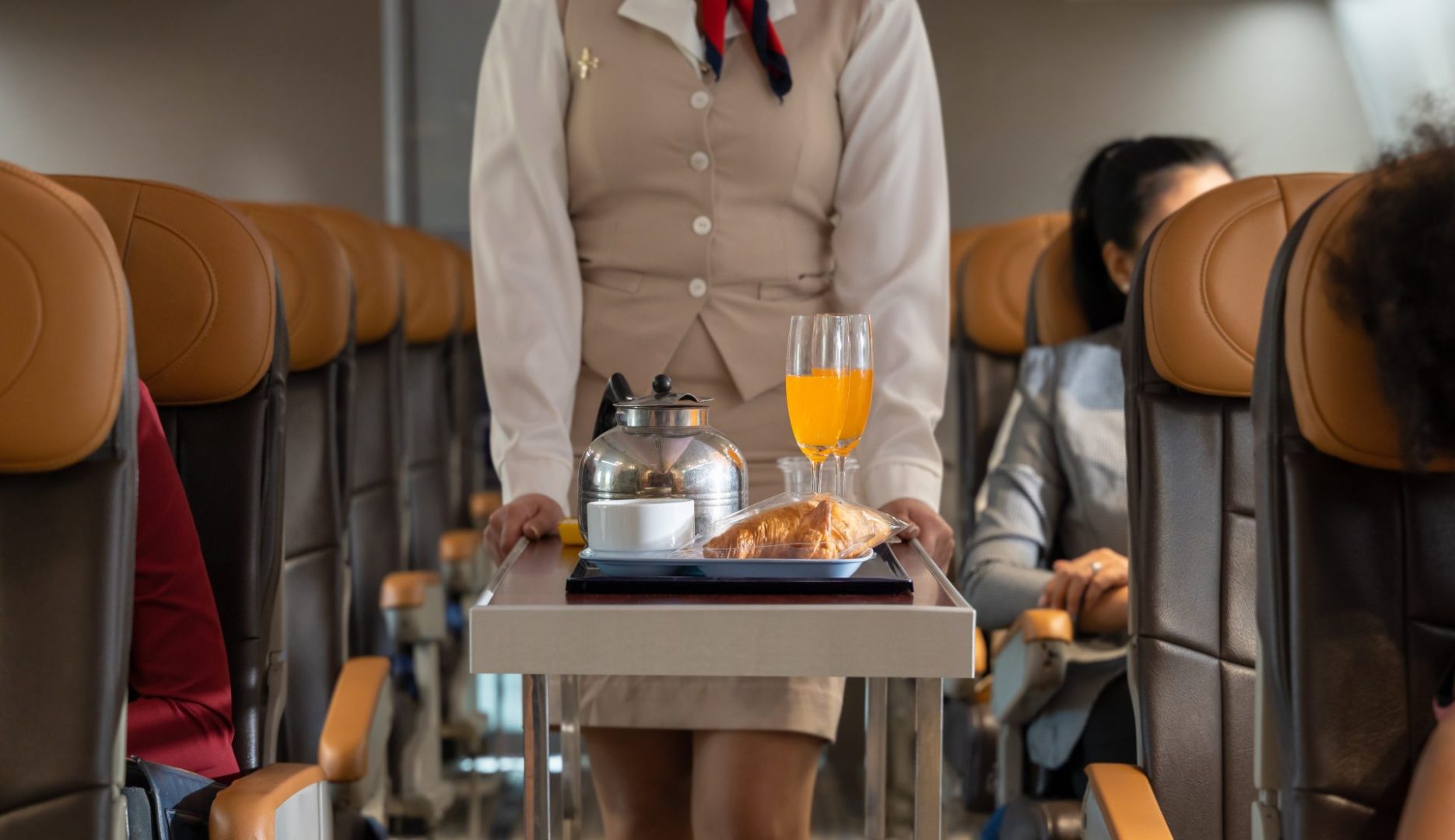That inflight meal or snack might be tempting when hunger strikes at 30,000 feet, but according to airline professionals who spend their careers in the sky, certain food and drink choices could turn your dream vacation into a nightmare before you even reach your destination.
Flight attendants, who witness thousands of dining decisions in the air, have developed strong opinions about which menu items passengers should avoid. Their insider knowledge—ranging from concerns about food safety to consideration for fellow travelers—offers valuable guidance for anyone planning to eat or drink during a flight.
The truth about airplane coffee and tea
That steaming cup of coffee might seem like the perfect way to wake up during an early morning flight, but cabin crew members often refuse this beverage themselves.
Most passengers don’t realize that leftover coffee is typically disposed of in the airplane lavatory, the entire coffee service system isn’t subject to the same rigorous sanitation standards you’d expect at your local café.
Multiple studies have confirmed concerning levels of bacteria in airplane water systems, leading many aviation professionals to stick strictly to bottled beverages. For caffeine-dependent travelers, grabbing coffee in the terminal before boarding provides a safer alternative to inflight brewing.
Why airplane meat dishes raise red flags
When flight attendants themselves avoid certain menu items, savvy travelers should take note. Meat-based main courses consistently top the list of foods aviation professionals skip while flying.
Temperature control is everything when it comes to food safety, especially with meat, between catering preparation, transportation to the aircraft, loading, and eventual service, meat dishes face multiple opportunities for temperature abuse.
Storage of prepared meals often falls to busy flight attendants managing numerous other responsibilities. Flight delays can further compromise food safety, leaving meat dishes vulnerable to dangerous bacterial growth long before they reach your tray table.
Experienced cabin crew members recommend selecting vegetarian options when available, as plant-based meals generally present lower food safety risks and often taste better after reheating in the limited galley equipment.
The unspoken rule about aromatic foods
Nothing creates silent tension in a confined aircraft cabin quite like pungent food aromas. Flight attendants universally agree that strong-smelling items should remain firmly on the ground.
Certain snacks earn particular notoriety among cabin crew. Corn nuts, with their distinctive powerful aroma, and barbecue-flavored chips rank among the most problematic offenders. These intense scents can permeate the recirculated cabin air, affecting everyone’s comfort for hours.
“In a space where hundreds of people share the same air supply, food choices become a matter of communal consideration,” one veteran flight attendant observes. “What you might enjoy eating could create genuine discomfort for those seated nearby.”
Seasoned travelers follow the unwritten rule of selecting neutral-smelling foods that won’t announce themselves to the entire cabin. Mild options like sandwiches, fresh fruit, or plain crackers provide satisfying alternatives that respect shared airspace.
Gas-inducing foods and high-altitude discomfort
The physics of air travel creates unique digestive challenges that flight attendants understand all too well. As cabin pressure changes, gases in the body naturally expand—a process that certain foods dramatically intensify.
Beans, cruciferous vegetables like broccoli and cauliflower, and many dairy products can cause bloating and gas even at ground level. At cruising altitude, these effects amplify significantly, creating uncomfortable pressure and potential embarrassment in close quarters.
The physical discomfort from gas-inducing foods can ruin your travel experience, beyond consideration for others, it’s about your own comfort during the flight.
Flight professionals recommend eating simply before and during flights, focusing on easily digestible options that won’t contribute to bloating. This approach helps maintain comfort throughout the journey and avoids digestive distress that might otherwise detract from your travel experience.
The deceptive dangers of inflight alcohol
That preflight cocktail might seem like the perfect way to ease travel anxiety, but flight attendants recognize the hidden risks of alcohol consumption at altitude. The reduced oxygen levels in pressurized cabins intensify alcohol’s effects, creating a dangerous situation many passengers fail to anticipate.
One drink in the air can affect you like two drinks on the ground, combined with the dehydrating effects of the cabin environment, alcohol can quickly lead to increased light-headedness and worsened jet lag upon arrival.
Particularly problematic are salt-heavy cocktails like Bloody Marys, which despite their popularity in flight, exacerbate the already dehydrating conditions of air travel. The combination of alcohol and high sodium content creates a perfect storm for feeling terrible upon landing.
Flight staff who regularly cross time zones typically avoid or strictly limit alcohol while flying, opting instead for regular water intake to maintain hydration and arrive feeling refreshed rather than depleted.
Water wisdom from frequent flyers
While avoiding certain beverages makes sense, staying hydrated remains crucial during air travel. Flight attendants emphasize the importance of drinking water while avoiding the mistake of requesting tap water onboard.
The same tanks supplying the coffee makers provide the tap water throughout the aircraft, experienced crew members bring their own bottled water or accept only sealed bottled water during flights.
Aviation professionals recommend drinking approximately eight ounces of water for every hour in the air to counteract the extremely dry cabin environment, which typically maintains humidity levels lower than the Sahara Desert.
This hydration habit helps maintain energy levels, supports immune function, and reduces the severity of jet lag upon arrival—benefits that make carrying an empty water bottle through security for post-checkpoint filling well worth the effort.
Navigating food allergies in shared airspace
For travelers with food allergies, airplanes present unique challenges that flight attendants witness regularly. The confined space means allergens can easily spread through recirculated air or surface contact.
Cabin crew members have seen severe allergic reactions develop mid-flight, sometimes requiring emergency landings or urgent medical intervention. This perspective has made many flight attendants extremely cautious about their own food choices when working.
“I’ve seen passengers open packages of peanuts three rows away from someone with a severe allergy, completely unaware of the potential danger they’re creating,” one flight attendant shares. “These situations have made me extremely mindful about my own food choices in shared spaces.”
For this reason, many aviation professionals avoid bringing common allergens onboard and suggest passengers consider similarly thoughtful choices when packing travel snacks.
Planning for pleasant travel experiences
Beyond avoiding problematic foods, flight attendants recommend several proactive strategies for comfortable dining while traveling:
Eat a satisfying meal before your flight to reduce the need for extensive inflight dining. This approach gives you more control over food quality and safety while minimizing the challenges of eating in limited space.
Pack simple, non-perishable snacks that travel well and won’t disturb others. Good options include plain crackers, dried fruit, or simple granola bars without strong aromas.
Time your meals according to your destination’s schedule rather than your departure point. This simple habit helps your body adjust to new time zones more efficiently, reducing the overall impact of jet lag.
Request special meals when booking your flight if you have specific dietary needs. These meals are prepared separately and often receive more individual attention than standard offerings.
By adopting these strategies used by aviation professionals, you can enjoy more comfortable, pleasant flights while showing consideration for your fellow travelers in the shared cabin environment.
The best travelers understand that their choices affect everyone around them, when hundreds of people share such a confined space for hours, mutual consideration becomes essential for a positive experience.














